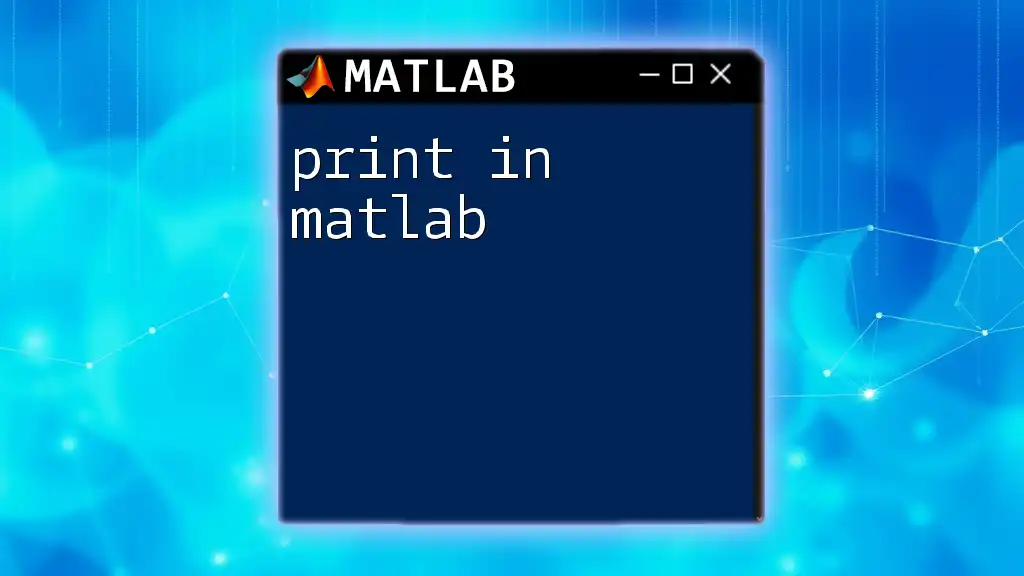The Fourier transform in MATLAB allows you to analyze the frequency components of a signal, using the `fft` function to compute the discrete Fourier transform.
Here's a simple code snippet demonstrating its usage:
% Sample signal generation
t = 0:0.001:1; % Time vector
signal = sin(2*pi*50*t) + sin(2*pi*120*t); % Signal composed of two frequencies
% Compute the Fourier transform
signal_fft = fft(signal);
% Frequency vector for plotting
fs = 1000; % Sampling frequency
f = (0:length(signal)-1)*fs/length(signal);
% Plotting the amplitude spectrum
figure;
plot(f, abs(signal_fft));
title('Amplitude Spectrum of the Signal');
xlabel('Frequency (Hz)');
ylabel('Amplitude');
xlim([0 fs/2]); % Limit the frequency axis to half the sampling frequency
What is Fourier Analysis?
Fourier analysis is a mathematical framework that allows us to break down a function or signal into its constituent frequencies. It provides a powerful way to analyze signals in various domains, most notably in the fields of signal processing, communications, and data analysis. The primary purpose is to understand how different frequency components contribute to the overall signal, making it crucial for tasks such as filtering, compression, and recognition.
Applications of Fourier analysis are widespread and include audio processing, image analysis, telecommunications, and even in solving differential equations. With the power of Fourier transforms, engineers and researchers can efficiently analyze and manipulate data in the frequency domain.

Importance of MATLAB in Fourier Analysis
MATLAB offers a robust environment for implementing Fourier analysis. Its features, such as intuitive syntax, built-in functions, and advanced visualization tools, facilitate quick learning and application. MATLAB specializes in matrix and numerical computations, which are fundamental to Fourier transforms, making it an invaluable resource for students, engineers, and researchers.

Continuous vs. Discrete Fourier Transform
Continuous Fourier Transform (CFT)
The Continuous Fourier Transform is used for analyzing continuous signals. It's defined mathematically by the integral:
$$ F(f) = \int_{-\infty}^{+\infty} f(t) e^{-j2\pi ft} dt $$
where \( f(t) \) is the signal in the time domain and \( F(f) \) represents the transformed signal in the frequency domain.
Discrete Fourier Transform (DFT)
The Discrete Fourier Transform is essential for analyzing discrete signals, typically generated from sampled data. It is defined as:
$$ X(k) = \sum_{n=0}^{N-1} x(n)e^{-j2\pi kn/N} $$
where \( N \) is the total number of samples, and \( x(n) \) is the discrete signal.
Relationship between CFT and DFT
While both transforms serve the purpose of frequency analysis, CFT is ideal for continuous signals, and DFT is tailored for discrete data. As a general rule of thumb, continuous transformations can be approximated by discrete transformations when the sampling rate is sufficiently high.

Implementing Fourier Transforms in MATLAB
Getting Started with MATLAB
Before diving into Fourier analysis, it's essential to familiarize yourself with basic MATLAB commands. Begin your MATLAB session with:
clc; % Clear the command window
clear; % Clear all variables
close all; % Close all figure windows
Fourier Transform Functions in MATLAB
Using `fft` for Discrete Fourier Transform
The `fft` function in MATLAB computes the Discrete Fourier Transform of a data set efficiently. It is crucial for analyzing periodic signals.
Here’s how to use it:
% Example of FFT in MATLAB
t = 0:0.001:1; % Time vector from 0 to 1 second with 1ms intervals
f = 5; % Frequency of the sine wave in Hz
signal = sin(2*pi*f*t); % Generate a sine wave signal with the specified frequency
Y = fft(signal); % Compute the FFT of the signal
Using `ifft` for Inverse Fourier Transform
The `ifft` function is essential for retrieving the original time-domain signal from its frequency representation.
For example:
% Example of IFFT in MATLAB
recovered_signal = ifft(Y); % Recover the original signal from its FFT
Visualizing Fourier Transforms
Plotting Frequency Spectrum
Visualizing the frequency spectrum is a fundamental aspect of Fourier analysis. It helps to identify the dominant frequencies in the signal.
Here’s how to plot it:
% Visualization of the FFT
f = (0:length(Y)-1)*100/length(Y); % Create a frequency vector based on sampling frequency
plot(f, abs(Y)); % Plot the magnitude of the FFT result
title('Frequency Spectrum'); % Title for the plot
xlabel('Frequency (Hz)'); % Label for the x-axis
ylabel('|Y(f)|'); % Label for the y-axis
Time-Domain vs. Frequency-Domain Representation
Understanding the distinction between time-domain and frequency-domain representations is critical.
% Plotting Time Domain Signal
subplot(2, 1, 1); % Create a subplot for time-domain representation
plot(t, signal); % Plot the original time-domain signal
title('Time Domain Signal'); % Title for the time-domain plot
xlabel('Time (s)'); % Label for the x-axis
ylabel('Amplitude'); % Label for the y-axis
% Plotting Frequency Domain Signal
subplot(2, 1, 2); % Create a subplot for frequency-domain representation
plot(f, abs(Y)); % Plot the frequency-domain signal
title('Frequency Spectrum'); % Title for the frequency-domain plot
xlabel('Frequency (Hz)'); % Label for the x-axis
ylabel('|Y(f)|'); % Label for the y-axis

Advanced Techniques in Fourier Analysis
Fast Fourier Transform (FFT) Optimization
The Fast Fourier Transform is an optimized algorithm for computing the DFT much faster than the naive approach. MATLAB's implementation is highly efficient, making it suitable for real-time applications. Using FFT can significantly reduce computational costs, especially for large data sets.
Practical Applications of Fourier in MATLAB
Audio Signal Processing
Fourier transforms are invaluable in audio signal processing for tasks such as filtering and compression.
Here’s a basic example of analyzing an audio signal:
[audio, fs] = audioread('audio_file.wav'); % Read an audio file into MATLAB
Y_audio = fft(audio); % Compute the FFT of the audio signal
Image Processing with Fourier Transforms
Fourier transforms are also used in image processing for filtering and analysis. By transforming an image into the frequency domain, you can apply various filters based on frequency components.
Example:
img = imread('image_file.png'); % Read an image file into MATLAB
img_FFT = fft2(img); % Compute the 2D FFT of the image

Recap of Key Concepts
In this article, we explored the fundamentals of Fourier in MATLAB. We examined the significance of Fourier transforms in analyzing signals and discussed practical implementations using MATLAB's powerful functions.

Encouragement to Practice
To gain a deeper understanding, practice using the commands and explore different applications in your projects. Experiment with audio and image files to see how Fourier transforms can unveil the hidden frequency components of your signals.

Additional Resources
Recommended Reading and Tutorials
For those looking to dive deeper into Fourier analysis and MATLAB, consider exploring recommended books, online courses, and tutorials specifically focused on signal processing and data analysis.
Community and Forums
Joining MATLAB-related forums can enhance your learning experience. Engaging with online communities allows you to seek help, share knowledge, and stay updated on the latest developments in MATLAB and signal processing.

















